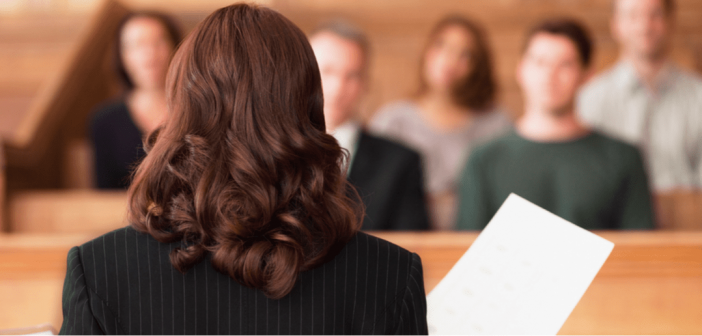On April 29, the Women in Urban Law Leadership Initiative (WIULLI) of Fordham Law’s Urban Law Center hosted a virtual panel*, “Feminist Lawyering in Criminal Court,” which provided insightful conversation about the challenges faced by women leaders in the criminal justice field, ranging from navigating implicit biases within the courtroom to dealing with inequities in gender parity.
The online discussion forum, moderated by Urban Law Center Director Geeta Tewari ’05, featured Danielle Eaddy ’91, bureau chief at the Kings County District Attorney’s Office; Sylvia Shweder ’05, deputy chief of the financial litigation unit of the U.S. Attorney’s Office for the Eastern District of New York; and Martha Rayner, clinical associate professor and co-director of Fordham Law’s Criminal Defense Clinic.
“Since I had already explored city government, employment law, and human rights in previous panels, I wanted to step away from civil law and highlight criminal law as an area for law students to learn more about as a career,” said Tewari, who launched WIULLI in spring 2019 to support lawyers and law students interested in the intersection of urban law and gender. “In that regard, I wanted to examine the gender issues within the field and to openly discuss them, so that students can think about these issues as they move forward in their careers.”
Implicit Bias in the Courtroom
According to Eaddy and Shweder, implicit bias affects trial strategy, including cross-examinations, and the way a lawyer presents herself through tone and even wardrobe. Eaddy said she has found over her 26-year-long career that judges—both men and women—at times treat women attorneys as if they don’t know what they’re doing in the courtroom, in front of a jury. She also noted that women lawyers, especially women of color, who are strident in the courtroom are often deemed as overaggressive.
“I don’t want to go into a courtroom and see one of my assistants acting unprofessional . . . juries are always looking at them,” Eaddy said. She further explained, “Juries don’t see the argument that happens outside of their presence. For example, the opposing attorney may have gotten you so upset, and then you come into the courtroom yelling.” Eaddy observed, “Juries hold it against you. They don’t mind if you react if they have seen someone has wronged you—then I think they champion you. But you really have to be careful about your tone as a woman. And it’s not just men who have these biases; women have them, too.”
When it comes to helping her students develop their professional personas, Rayner urges them to be mindful and deliberate with their choice of clothes. She also recounted a story from her early attorney days when she had accidentally bumped into a juror at her local grocery store after losing a case.
“The juror said to me, ‘You did a really good job and did a really nice presentation, but … let me just give you a few notes. You really need to wear makeup,’” Rayner said. “That made such an impression on me, of course, as a young lawyer, but it really reminded me that when I’m in the courtroom it’s not about me. It’s about me as a lawyer, an advocate, and often the sole representative of my client.”
Advancing Gender Parity
During the conversation, Tewari pointed to a 2017 report from the New York State Bar Association that concluded women attorneys made up only 25 percent of the lead counsel in the Southern District of New York. That report later stated, “The low percentage of women attorneys appearing in a speaking role in courts was found at every level and in every type of court: upstate and downstate, federal and state, trial and appellate, criminal and civil, ex parte applications, and multi-party matters.”
However, Tewari noted one anomaly in the U.S. District Court for the Southern District of New York. In the courtroom of the late Judge Deborah A. Batts, women represented 46 percent of the lead attorneys. “That indicates that, with inclusive community building and open conversation between the sexes and diverse groups, we can build a fairer, more equitable justice system,” Tewari said.
Shweder suggested that more men in the legal community can become allies to women in the fight to increase gender parity. One way this could be achieved, she offered, is by bringing women to second chair and helping the lead attorney during the trial by examining some of the witnesses or presenting the opening statement or closing argument. However, Shweder also said women need to help each other succeed, lift each other up, and advance within the field. “We all can change [gender parity]when we’re in positions of power and even not in positions of power,” she said.
In the same vein, Rayner said that she has seen improvements over the decades for women in the legal profession. “Obviously we’re far from where we want to be, but I have seen progress,” she said. “We have a long way to go, and, as Sylvia said, we can’t do this alone. I hope there’s a panel of men somewhere that are talking about the same issues we’re talking about.”
*The event was presented in conjunction with the Access to Justice Initiative, Clinical Legal Education Program, Fordham Law Women, and Urban Law Journal, and generously sponsored by Patterson Belknap Webb & Tyler LLP and the New York Women’s Bar Association Foundation. It was also supported by Professor Nestor Davidson, faculty director of the Fordham Urban Law Center and Albert A. Walsh Chair in Real Estate, Land Use, and Property Law.





